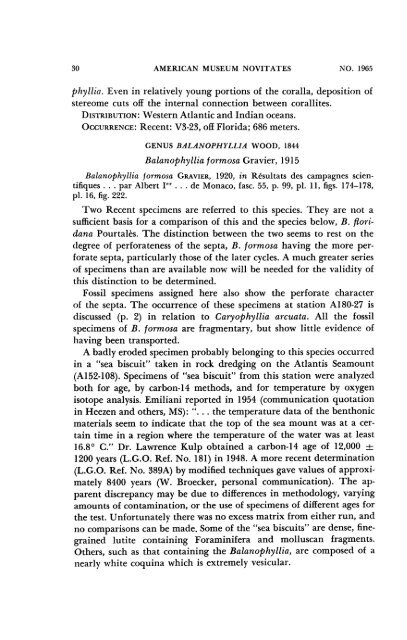MXieuicanJAuscum - American Museum of Natural History
MXieuicanJAuscum - American Museum of Natural History
MXieuicanJAuscum - American Museum of Natural History
You also want an ePaper? Increase the reach of your titles
YUMPU automatically turns print PDFs into web optimized ePapers that Google loves.
30 AMERICAN MUSEUM NOVITATES<br />
NO. 1965<br />
phyllia. Even in relatively young portions <strong>of</strong> the coralla, deposition <strong>of</strong><br />
stereome cuts <strong>of</strong>f the internal connection between corallites.<br />
DISTRIBUTION: Western Atlantic and Indian oceans.<br />
OCCURRENCE: Recent: V3-23, <strong>of</strong>f Florida; 686 meters.<br />
GENUS BALANOPHYLLIA WOOD, 1844<br />
Balanophyllia formosa Gravier, 1915<br />
Balanophyllia formosa GRAVIER, 1920, in R6sultats des campagnes scientifiques<br />
. . . par Albert ler ... de Monaco, fasc. 55, p. 99, pl. 11, figs. 174-178,<br />
pl. 16, fig. 222.<br />
Two Recent specimens are referred to this species. They are not a<br />
sufficient basis for a comparison <strong>of</strong> this and the species below, B. floridana<br />
Pourtales. The distinction between the two seems to rest on the<br />
degree <strong>of</strong> perforateness <strong>of</strong> the septa, B. formosa having the more perforate<br />
septa, particularly those <strong>of</strong> the later cycles. A much greater series<br />
<strong>of</strong> specimens than are available now will be needed for the validity <strong>of</strong><br />
this distinction to be determined.<br />
Fossil specimens assigned here also show the perforate character<br />
<strong>of</strong> the septa. The occurrence <strong>of</strong> these specimens at station A180-27 is<br />
discussed (p. 2) in relation to Caryophyllia arcuata. All the fossil<br />
specimens <strong>of</strong> B. formosa are fragmentary, but show little evidence <strong>of</strong><br />
having been transported.<br />
A badly eroded specimen probably belonging to this species occurred<br />
in a "sea biscuit" taken in rock dredging on the Atlantis Seamount<br />
(A152-108). Specimens <strong>of</strong> "sea biscuit" from this station were analyzed<br />
both for age, by carbon-14 methods, and for temperature by oxygen<br />
isotope analysis. Emiliani reported in 1954 (communication quotation<br />
in Heezen and others, MS): ". . . the temperature data <strong>of</strong> the benthonic<br />
materials seem to indicate that the top <strong>of</strong> the sea mount was at a certain<br />
time in a region where the temperature <strong>of</strong> the water was at least<br />
16.80 C." Dr. Lawrence Kulp obtained a carbon-14 age <strong>of</strong> 12,000 +<br />
1200 years (L.G.O. Ref. No. 181) in 1948. A more recent determination<br />
(L.G.O. Ref. No. 389A) by modified techniques gave values <strong>of</strong> approximately<br />
8400 years (W. Broecker, personal communication). The apparent<br />
discrepancy may be due to differences in methodology, varying<br />
amounts <strong>of</strong> contamination, or the use <strong>of</strong> specimens <strong>of</strong> different ages for<br />
the test. Unfortunately there was no excess matrix from either run, and<br />
no comparisons can be made. Some <strong>of</strong> the "sea biscuits" are dense, finegrained<br />
lutite containing Foraminifera and molluscan fragments.<br />
Others, such as that containing the Balanophyllia, are composed <strong>of</strong> a<br />
nearly white coquina which is extremely vesicular.
















